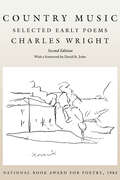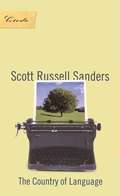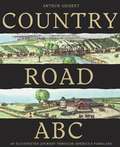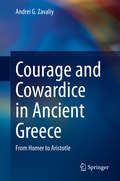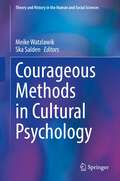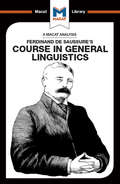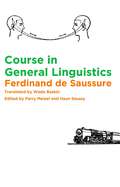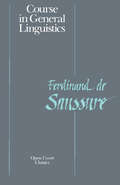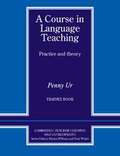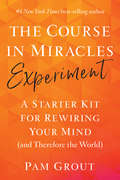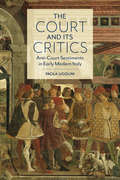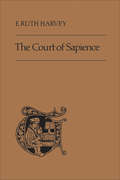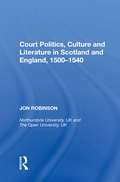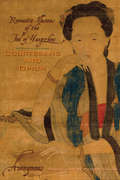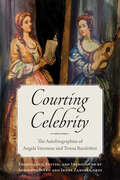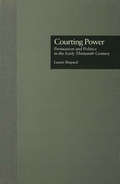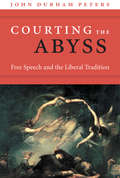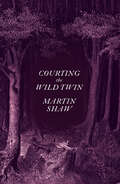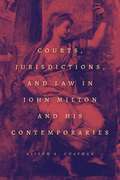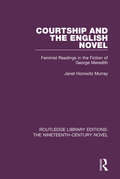- Table View
- List View
Country Music: Selected Early Poems (Wesleyan Poetry Series)
by Charles WrightA compilation of powerful and moving poems from early in the poet's career. Co-winner of the 1983 National Book Award for Poetry, Country Music is comprised of eighty-eight poems selected from Charles Wright's first four books published between 1970 and 1977. From his first book, The Grave of the Right Hand, to the extraordinary China Trace, this selection of early works represents "Charles Wright's grand passions: his desire to reclaim and redeem a personal past, to make a reckoning with his present, and to conjure the terms by which we might face the future," writes David St. John in the forward. These poems, powerful and moving in their own right, lend richness and insight to Wright's recently collected later works. "In Country Music we see the same explosive imagery, the same dismantled and concentric (or parallel) narratives, the same resolutely spiritual concerns that have become so familiar to us in Wright's more recent poetry," writes St. John.
Country of Language
by Scott R. SandersScott Russell Sanders argues that people need to find a sense of "at-homeness" in the natural world because moments of interaction with the nonhuman world restore sanity and courage in the face of life's trials.
Country Road ABC
by Arthur GeisertOn today's farm, B is for barn cat...E is for erosion...G is for grinding feed, and I is for...inoculate? In 26 beautifully detailed spreads, acclaimed illustrator Arthur Geisert takes readers on a literal journey following a real road in Iowa (County Road Y31) through the ins and outs of America's farmland. This isn't your grandfather's farm book. It still features pigs, hay, and other familiar farm residents, but you'll see a very different kind of quicksand and traffic jam here...Along the bottom of each page is a continuous panorama that totals nearly forty feet of art. Country Road ABC is a unique and funny look at America's present-day farmland.
Courage and Cowardice in Ancient Greece: From Homer to Aristotle
by Andrei G. ZavaliyThe book offers the first comprehensive account of the debate on true courage as it was raging in ancient Greece, from the times when the immensely influential Homeric epics, the Iliad and the Odyssey, were composed, to the period of the equally influential author, Aristotle. The many voices that contribute to this debate include poets, authors of ancient dramas and comedies, historians, politicians and philosophers. The book traces the origin of the earliest ideal of a courageous hero in the epic poems of Homer (8th century BCE), and faithfully records its transformations in later authors, which range from an emphatic denial of the Homeric standards of courage (as in comedies of Aristophanes and some Dialogues of Plato) to the strong revisionist tendencies of Aristotle, who attempts to restore genuine courage to its traditional place as an exclusively martial, male virtue.Without attempting to cover the whole of the Western history, the book is able to explore the most important primary Greek sources on the subject matter in greater details, and provide the reader with a comprehensive picture of the changes in both popular and philosophical conceptualizations of the standards of courage from the Archaic period to the middle of the 4th century BCE. A deeper understanding of the history of the debate on courage should help to shape the modern discussions as well, as it becomes obvious that many of the questions on courage and cowardice that are still raised by the contemporary authors from different fields, have been thoroughly considered during the early stages of Greek culture. The book seeks to undermine a common stereotype of a single, unified view on courage and cowardice in Ancient Greece and shows that the current debates on what constitutes genuine courageous character can be traced to the various direct and indirect discussions on this subject matter by the ancient authorities.
The Courage to Write: How Writers Transcend Fear
by Ralph KeyesThe Courage to Write is an invaluable book and essential reading for anyone who wishes to learn how to write well.Katherine Anne Porter called courage "the first essential" for a writer. "I have to talk myself into bravery with every sentence," agreed Cynthia Ozick, "sometimes every syllable." E. B. White said he admired anyone who "has the guts to write anything at all."An author who has taught writing for more than thirty years,In The Courage to Write, Ralph Keyes, an author who has taught writing for more than thirty years, assures us that anxiety is felt by writers at every level, especially when they dare to do their best. He describes the sequence of "courage points" through which all writers must pass, from the challenge of identifying a worthwhile project to the mixture of pride and panic they feel when examining a newly published book or article. Keyes also offers specifics on how to root out dread of public "performance" and of the judgment of family and friends, make the best use of writers' workshops and conferences, and handle criticism of works in progress. Throughout, he includes the comments of many accomplished writers -- Pat Conroy, Amy Tan, Rita Dove, Isabel Allende, and others -- on how they transcended their own fears to produce great works.
Courageous Methods in Cultural Psychology (Theory and History in the Human and Social Sciences)
by Meike Watzlawik Ska SaldenInnovative research requires courageous methods. With this in mind, Courageous Methods in Cultural Psychology invites students and post-graduate researchers to develop methods that will let them grasp phenomena of interest more fully. Readers will learn how to use established methods, and may be asked to develop them further by combining single steps of extant procedures, or by taking a completely new approach to data collection and analysis. In this book, diverse researchers present projects in which they have tried to do just that. A comprehensive process — from narrowing down research questions to collecting and analyzing data — is given in detail, followed by critical reflections on how well the authors have understood and shared complex realities. Project presentations are framed by theoretical chapters that deal with the challenges and opportunities of cultural psychology and interdisciplinary research. Courageous Methods in Cultural Psychology is sure to inspire and encourage those who wish to venture on new roads “into the wild.”
Course in General Linguistics
by Brittany Pheiffer Noble Laura E.B. KeyFerdinand de Saussure’s Course in General Linguistics is one of the most influential texts of the 20th-century – an astonishing feat for what is, at heart, a series of deeply technical lectures about the structure of human languages. What the Course’s vast influence shows, fundamentally, is the power of good interpretative skills. The interpretative tasks of laying down and clarifying definitions are often vital to providing the logical framework for all kinds of critical thinking – whether it be solving problems in business, or esoteric academic research. At the time sat which Saussure gave his lectures, linguistics was a scattered and inconsistent field, without a unified method or rigorous approach. He aimed to change that by setting down and clarifying definitions and distinctions that would provide a coherent methodological framework for the study of language. The terms laid down in the Course did exactly that – and they still make up the core of linguistic terminology a full century later. More than this, however, Saussure also highlighted the centrality of linguistic interpretation to understanding how we relate to the world, founding “semiotics”, or the study of signs – a field whose influence on academics across the humanities and social sciences is unparalleled.
Course in General Linguistics (Bloomsbury Revelations Ser.)
by Ferdinand de SaussureThe founder of modern linguistics, Ferdinand de Saussure inaugurated semiology, structuralism, and deconstruction and made possible the work of Jacques Derrida, Roland Barthes, Michel Foucault, and Jacques Lacan, thus enabling the development of French feminism, gender studies, New Historicism, and postcolonialism. Based on Saussure's lectures, Course in General Linguistics (1916) traces the rise and fall of the historical linguistics in which Saussure was trained, the synchronic or structural linguistics with which he replaced it, and the new look of diachronic linguistics that followed this change. Most important, Saussure presents the principles of a new linguistic science that includes the invention of semiology, or the theory of the "signifier," the "signified," and the "sign" that they combine to produce.This is the first critical edition of Course in General Linguistics to appear in English and restores Wade Baskin's original translation of 1959, in which the terms "signifier" and "signified" are introduced into English in this precise way. Baskin renders Saussure clearly and accessibly, allowing readers to experience his shift of the theory of reference from mimesis to performance and his expansion of poetics to include all media, including the life sciences and environmentalism. An introduction situates Saussure within the history of ideas and describes the history of scholarship that made Course in General Linguistics legendary. New endnotes enlarge Saussure's contexts to include literary criticism, cultural studies, and philosophy.
Course in General Linguistics
by Ferdinand La SaussureThe Cours de linguistique generale, reconstructed from students' notes after Saussure's death in 1913, founded modern linguistic theory by breaking the study of language free from a merely historical and comparativist approach. Saussure's new method, now known as Structuralism, has since been applied to such diverse areas as art, architecture, folklore, literary criticism, and philosophy.
A Course in Language Teaching
by Penny UrThis book provides all the task material, essential reading and worksheets from A Course in Language Teaching, but without background information, bibliographies, notes or solutions. The tasks, which focus on both practical and theoretical aspects, are designed to encourage critical reflection on key topics of language teaching. It is suitable for those studying on a trainer-led course, where the trainer is available to provide input, guidance and feedback.
The Course in Miracles Experiment: A Starter Kit for Rewiring Your Mind (and Therefore the World)
by Pam GroutACIM, the Fun Version! A real-world rewrite of the lessons of A Course in Miracles by the #1 New York Times best-selling author of E-Squared.A Course in Miracles is profound, deeply moving, and as boring to read as a bookshelf assembly manual.Ask for a show of hands at any self-help gathering, and 95 percent will happily admit to owning the dense blue book that's a famous resource for spiritual transformation. Ask the obvious follow-up, "How many have actually read it?" and all but a smattering of hands go down. It's as if everyone wants the miracles, the forgiveness, and the mind shifts, but they just can't bear its ponderous heaviness. Pam Grout to the rescue! Her new book is for all those still struggling with the Course. Grout offers a modern-day rewrite of the 365-lesson workbook-the text at the heart of the Course. Unlike the original, it's user-friendly, accessible and easy for everyone to understand.In daily lessons with titles like "The Home Depot of Spiritual Practices" and "Transcending the Chatty Asshat in My Head," Grout drills down to the Course's essential message and meaning, grounding it in the context of everyday life in a way that's bound to stick. The lessons here blend eternal truths with pop culture and personal stories that are laugh-out-loud funny and deeply soul-stirring, often at the same time. You won't be tempted to use this Course in Miracles as a doorstop. You'll want to use it, every day, to change your life.
The Court and Its Critics: Anti-Court Sentiments in Early Modern Italy (Toronto Italian Studies)
by Paola UgoliniAnti-courtly discourse furnished a platform for discussing some of the most pressing questions of early modern Italian society. The court was the space that witnessed a new form of negotiation of identity and prestige, the definition of masculinity and of gender-specific roles, the birth of modern politics and of an ethics based on merit and on individual self-interest. The Court and Its Critics analyzes anti-courtly critiques using a wide variety of sources including manuals of courtliness, dialogues, satires, and plays, from the mid-fifteenth to the early seventeenth century. The book is structured around four key figures that embody different features of anti-courtly sentiments. The figure of the courtier shows that sentiments against the court were present even among those who apparently benefitted from such a system of power. The court lady allows an investigation of the intertwining between anti-courtliness and anti-feminism. The satirist and the shepherd of pastoral dramas are investigated as attempts to fashion two different forms of a new self for the court intellectual.
The Court of Sapience
by Elizabeth Ruth HarveyThe medieval English allegorical poem, The Court of Sapience, was written in the middle of the fifteenth century by an unknown author. It is best described as an encyclopaedia: in the allegory the poet describes the nature and activities of wisdom in all its aspects. He includes a moving account of the fall of a man and his restoration by divine wisdom; then he leads his dreamer through a landscape where all the traditional beauties of nature are catalogued and assigned their properties. The visit to the castle of Sapience, inhabited by all the branches of learning and the seven restorative virtues, completes the poem as we have it. The first edition was an early production of Caxton's press, and it was reprinted by his successor, Wynkyn de Worde. This is a new edition of Caxton's text of the poem. Variant readings from the extant manuscripts have investigated in detail and are discussed in the lengthy introduction and extensive commentary. The poem is an attractive work in itself, and has been admired by C.S. Lewis and other modern critics. It is also a valuable witness to the taste of the early Tudor period.
Court Politics, Culture and Literature in Scotland and England, 1500-1540
by Jon RobinsonThe focus of this study is court literature in early sixteenth-century England and Scotland. The author examines courtly poetry and drama in the context of a complex system of entertainment, education, self-fashioning, dissimulation, propaganda and patronage. He places selected works under close critical scrutiny to explore the symbiotic relationship that existed between court literature and important socio-political, economic and national contexts of the period 1500 to 1540. The first two chapters discuss the pervasive influence of patronage upon court literature through an analysis of the panegyric verse that surrounded the coronation of Henry VIII. The rhetorical strategies adopted by courtiers within their literary works, however, differed, depending on whether the writer was, at the time of writing the verse or drama, excluded or included from the environs of the court. The different, often elaborate rhetorical strategies are, through close readings of selected verse, delineated and discussed in chapter three on David Lyndsay and chapter four on Thomas Wyatt and Thomas Elyot.
Court Reporting: Bad Grammar Good Punctuation Workbook
by Margaret Wakeman WellsA language arts workbook for court reporting
Courteous Capitalism: Public Relations and the Monopoly Problem, 1900-1930
by Christopher Cannon and Steven JusticeCourtesans and Opium: Romantic Illusions of the Fool of Yangzhou (Weatherhead Books on Asia)
by AnonymousIn his preface, the anonymous author of Courtesans and Opium describes his book as an act of penance for thirty years spent patronizing the brothels of Yangzhou. Written in the 1840s, his story is filled with vice and dark consequence, portraying the hazards of the city's seedy underbelly and warning others against the example of the Fool.Chinese literature's first true "city novel," Courtesans and Opium recounts the illustrious career of a debauched soul enveloped by enthralling pursuits and romantic illusions. While socially acceptable marriages were arranged and often loveless, brothels offered men accomplished courtesans who served as both enchanting companions and sensual lovers. These professional sirens dressed in the latest styles and dripped with gold, silver, and jewels. From an early age, they were taught to excel at various arts and graces, which transformed the brothel into a kind of club for men to meet, exchange gossip, and smoke opium at their leisure.The Fool's fable follows five sworn brothers and their respective relationships with Yangzhou courtesans, revealing in acute detail the lurid materialism of this dangerous world—its violence and corruption as well as its seductive but illusory promise. Never before translated into English, Courtesans and Opium offers a brilliant window into the decadence of nineteenth-century China.
Courtesy Lost
by Kristina Marie OlsonIn Courtesy Lost, Kristina M. Olson analyses the literary impact of the social, political, and economic transformations of the fourteenth century through an exploration of Dante's literary and political influence on Boccaccio. The book reveals how Boccaccio rewrote the past through the lens of the Commedia, torn between nostalgia for elite families in decline and the need to promote morality and magnanimity within the Florentine Republic.By examining the passages in Boccaccio's Decameron, De casibus, and Esposizioni in which the author rewrites moments in Florentine and Italian history that had also appeared in Dante's Commedia, Olson illuminates the ways in which Boccaccio expressed his deep ambivalence towards the political and social changes of his era. She illustrates this through an analysis of Dante's and Boccaccio's treatments of the idea of courtesy, or cortesia, in an era when the chivalry of the declining aristocracy was being supplanted by the civility of the rising merchant classes.
Courting Celebrity: The Autobiographies of Angela Veronese and Teresa Bandettini (Toronto Italian Studies)
by Adrienne Ward Irene Zanini-CordiIn 1826 Angela Veronese, a gardener’s daughter, wrote and published the first modern autobiography by an Italian woman. Veronese’s account focuses on her unique experience as a peasant girl who came of age among the Venetian elite, and details how she attained a certain renown in and out of Italy by improvising, writing, and publishing her own lyrics. Courting Celebrity is a bilingual annotated edition of Veronese’s autobiography. To better elucidate Veronese’s thinking, the book includes the autobiographical writing of another contemporary Italian poet, Teresa Bandettini, a well-known Tuscan poet-improviser. The book offers a substantial sample of Veronese’s poems, translated and in the original. These compositions, together with detailed bibliographical documentation, point to the success of Veronese’s autobiographical enterprise and offer an unparalleled view of both high society and popular culture at the time. Courting Celebrity illustrates women’s practice in two key literary genres, poetry and autobiography, and illuminates the strategies of women’s self-fashioning and pursuit of celebrity.
Courting Power: Persuasion and Politics in the Early Thirteenth Century (Garland Studies in Medieval Literature #17)
by Laurie ShepardThis text chronicles a change in epistolary persuasion in the 1230's, crystallized at the imperial chancery of Frederick II, Emperor from 1220-1250. There, traditional appeals, premised on authority and harmony, were challenged by letters in which historical circumstances functioned as an integral part of the strategy of persuasion. Based on the close reading of "Artes Dictandi", as well as a series of letters issued from the papal and imperial chanceries, this book explores the theory and practice of medieval letter-writing. Letters are evaluated as verbal acts intended to persuade, with the public as the ultimate arbiter of success. The author argues that the form, proportion and style of letters were contoured by ideology.
Courting the Abyss: Free Speech and the Liberal Tradition
by John Durham PetersCourting the Abyss updates the philosophy of free expression for a world that is very different from the one in which it originated. The notion that a free society should allow Klansmen, neo-Nazis, sundry extremists, and pornographers to spread their doctrines as freely as everyone else has come increasingly under fire. At the same time, in the wake of 9/11, the Right and the Left continue to wage war over the utility of an absolute vision of free speech in a time of increased national security. Courting the Abyss revisits the tangled history of free speech, finding resolutions to these debates hidden at the very roots of the liberal tradition. A mesmerizing account of the role of public communication in the Anglo-American world, Courting the Abyss shows that liberty's earliest advocates recognized its fraternal relationship with wickedness and evil. While we understand freedom of expression to mean "anything goes," John Durham Peters asks why its advocates so often celebrate a sojourn in hell and the overcoming of suffering. He directs us to such well-known sources as the prose and poetry of John Milton and the political and philosophical theory of John Locke, Adam Smith, John Stuart Mill, and Oliver Wendell Holmes Jr., as well as lesser-known sources such as the theology of Paul of Tarsus. In various ways they all, he shows, envisioned an attitude of self-mastery or self-transcendence as a response to the inevitable dangers of free speech, a troubled legacy that continues to inform ruling norms about knowledge, ethical responsibility, and democracy today. A world of gigabytes, undiminished religious passion, and relentless scientific discovery calls for a fresh account of liberty that recognizes its risk and its splendor. Instead of celebrating noxious doctrine as proof of society's robustness, Courting the Abyss invites us to rethink public communication today by looking more deeply into the unfathomable mystery of liberty and evil.
Courting the Wild Twin
by null Martin Shaw"Fabulous."—Dan Richards, author of Holloway"Terrifically strange and thrilling."—Melissa Harrison, author of All Among the Barley"A modern-day bard."—Madeline Miller, author of CirceThis is a book of literary activism – an antidote to the shallow thinking that typifies our age. In Courting the Wild Twin, acclaimed scholar, mythologist and author of Smoke Hole and Bardskull, Martin Shaw unravels two ancient European fairy tales concerning the mysterious &‘wild twin&’ located deep inside all of us. By reading these tales and becoming storytellers ourselves, he challenges us to confront modern life with purpose, courage, and creativity.Martin summons the reader to the "ragged edge of the dark wood" to seek out this estranged, exiled self – the part we generally shun or ignore to conform to societal norms – and invite it back into our consciousness. If there was something we were meant to do with our few, brief years on Earth, we can be sure that our wild twin is holding the key.After all, stories are our secret weapons – and they might just save us.
Courts, Jurisdictions, and Law in John Milton and His Contemporaries
by Alison A. ChapmanJohn Milton is widely known as the poet of liberty and freedom. But his commitment to justice has been often overlooked. As Alison A. Chapman shows, Milton’s many prose works are saturated in legal ways of thinking, and he also actively shifts between citing Roman, common, and ecclesiastical law to best suit his purpose in any given text. This book provides literary scholars with a working knowledge of the multiple, jostling, real-world legal systems in conflict in seventeenth-century England and brings to light Milton’s use of the various legal systems and vocabularies of the time—natural versus positive law, for example—and the differences between them. Surveying Milton’s early pamphlets, divorce tracts, late political tracts, and major prose works in comparison with the writings and cases of some of Milton’s contemporaries—including George Herbert, John Donne, Ben Jonson, and John Bunyan—Chapman reveals the variety and nuance in Milton’s juridical toolkit and his subtle use of competing legal traditions in pursuit of justice.
Courtship and the English Novel: Feminist Readings in the Fiction of George Meredith (Routledge Library Editions: The Nineteenth-Century Novel #30)
by Janet Horowitz MurrayFirst published in 1987, these essays deal with the three major novels of George Meredith. It explores in particular Meredith’s feminism and demonstrates how each novel embodies his very modern views of the relations between the sexes. This book will be of interest to those studying 19th Century literature and feminism.
Cousins at One Remove: Anglo-German Studies
by R.F.M. Byrn"This collection of essays is a sequel to ""Anglo-German Studies"" published in 1992 by the Leeds Philosophical and Literary Society. The emphasis of this volume is on the English reception of German literature."
